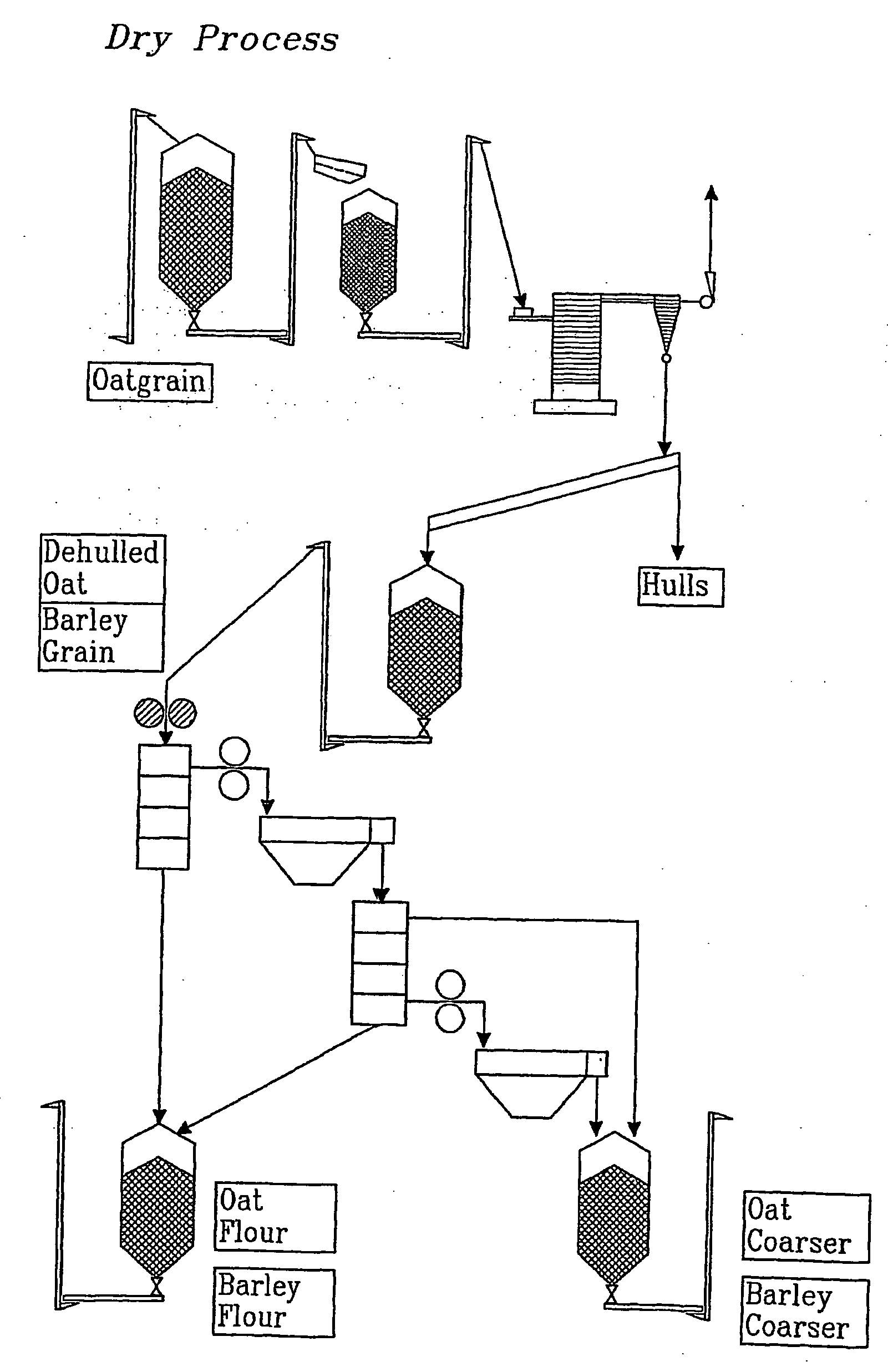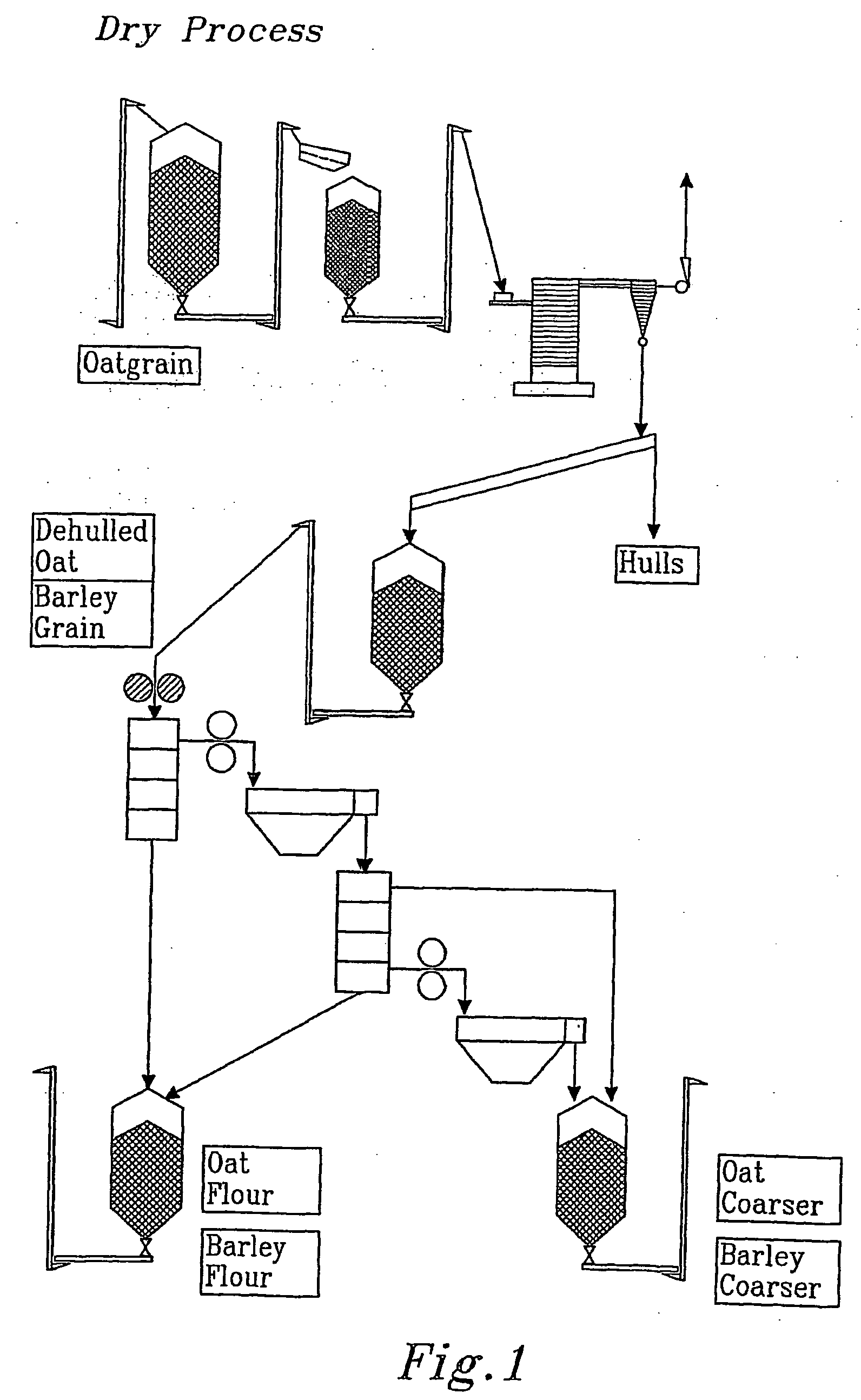Soluble dietary fibre from oat and barley grains, method for producing a fraction rich in B-glucan and use of the fraction in foods, pharmaceuticals and cosmetics
a technology oats, which is applied in the field of soluble dietary fibre from oats and barley grains, can solve the problems of no process, no product with a particularly high content of -glucan, etc., and achieve the effect of maximising the amount of high molecular weight soluble dietary fibr
- Summary
- Abstract
- Description
- Claims
- Application Information
AI Technical Summary
Benefits of technology
Problems solved by technology
Method used
Image
Examples
example 1
[0091] Raw material was prepared as follows: Oat grain was first de-hulled and the de-hulled grains were dry milled and 50% by weight of the grain was retained as a coarser fraction. 575 g of this material was suspended in 4 liters of water at a temperature of 95° C., in a 5 liter reaction vessel fitted with a mechanical stirrer. α-amylase enzyme (35 units) was added to the suspension and the mixture was incubated, with stirring and intermittent wet-milling, for 1 hour After this time, the pH was dropped to 4.5, the temperature lowered to 75° C. and amyloglucosidase (AMG) enzyme was added (35 units), the mixture being incubated for 15 minutes with stirring. Enzymes were then completely de-activated by heating of the suspension in an autoclave at 140° C. for some minutes.
[0092] The resulting suspension was then centrifuged, producing four distinct layers which were separated and collected: a viscous top layer rich in soluble dietary fibre, particularly β-glucan, an aqueous layer com...
example 2
[0097] Barley grain was dry milled to remove excess endosperm material and 50% of the milled grain, representing the coarser fraction, was utilized as the raw material for the trial.
[0098] 575 g of this material was suspended in 4 liters of water at a temperature of 95° C., in a 5 liter reaction vessel fitted with a mechanical stirrer. α-amylase enzyme (35 units) was added to the suspension and the mixture was incubated, with stirring and intermittent wet-milling, for 1 hour. After this time, the pH was dropped to 4.5, the temperature lowered to 75° C. and amyloglucosidase (AMG) enzyme was added (35 units), the mixture being incubated for 15 minutes with stirring. Enzymes were then completely de-activated by heating of the suspension in an autoclave at 140° C. for some minutes.
[0099] The resulting suspension was then centrifuged, producing four distinct layers which were separated and collected; a viscous top layer rich in soluble dietary fibre, particularly β-glucan, an aqueous l...
example 3
[0104] The same raw material as prepared in example 1 was used in this trial. 150 Kg of this material was added to 1050 liters of water at 95° C. in a 2,000 liter tank fitted with mechanical stirring.
[0105]α-amylase enzyme (9100 units) was added to the suspension and the mixture was incubated, with stirring and intermittent wet-milling, for 1 hour. After this time, the pH was dropped to 4.5using 84% orthophosphoric acid, the temperature lowered to 75° C. and amyloglucosidase (AMG) enzyme was added (9000 units), the mixture being incubated for 15 minutes with stirring. Enzymes were then completely de-activated by heating the resultant suspension by passing through a tubular heat exchanger at 140° C. The partially cooled hydrolysate suspension was then pumped into a 3-phase decantor and three fractions were obtained: a viscous top-layer rich in soluble dietary fibres, an aqueous fraction and a fraction containing most of the protein, fat and insoluble fibre from the milled oat grain....
PUM
| Property | Measurement | Unit |
|---|---|---|
| molecular weight | aaaaa | aaaaa |
| molecular weight | aaaaa | aaaaa |
| molecular weight | aaaaa | aaaaa |
Abstract
Description
Claims
Application Information
 Login to View More
Login to View More - R&D
- Intellectual Property
- Life Sciences
- Materials
- Tech Scout
- Unparalleled Data Quality
- Higher Quality Content
- 60% Fewer Hallucinations
Browse by: Latest US Patents, China's latest patents, Technical Efficacy Thesaurus, Application Domain, Technology Topic, Popular Technical Reports.
© 2025 PatSnap. All rights reserved.Legal|Privacy policy|Modern Slavery Act Transparency Statement|Sitemap|About US| Contact US: help@patsnap.com



